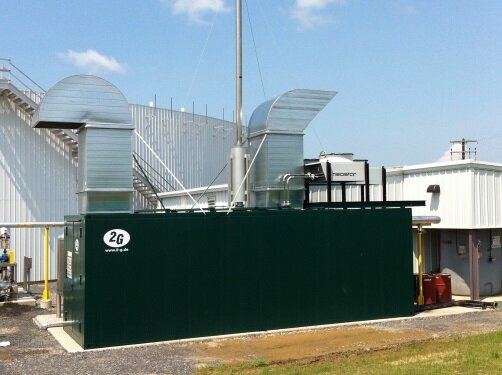How a food processing plant in PA turned its wastewater into green energy.
2G Patruus 250 with MAN engine installed in a sound-attenuated CHP container module, along with gas treatment system. and H2S removal technology
Facts & figures

A well-known food processing plant in Northumberland, PA, is the premier producer of beans and tomatoes in the Susquehanna River Valley. Due to increased production, the company's on-site wastewater treatment system required upgrading and expansion. In keeping with their environmental commitments, the customer was interested in generating green energy from their wastewater. ADI was awarded a contract to design and build an anaerobic system for the digestion of organic wastes. They also supplied a highly efficient biogas CHP system for the production of electricity and thermal energy from the biogas produced by the new digester.
The CHP cogeneration plant consists of a 2G Patruus 250 with an integrated MAN engine capable of producing 250 ekW/h or 2,075 MW p.a. Electrical Power and 322 kWh/th Thermal Power, all built in a 30' sound-attenuated CHP container module. Additionally, 2G Energy Inc. installed a complete gas treatment system, including biogas, dehumidification, and reheating system, and the double vessel H2S removal technology. Since the customer's wastewater flow and volume vary considerably throughout the year, the system needed to accommodate fluctuations in load while maintaining consistent performance and maximizing biogas utilization. The anaerobic system designed by ADI consists of a 7.5 MG ADI-BVF® reactor, complete with internal influent/effluent distribution piping, mixer, biogas collection/handling, and a sophisticated, yet simple, graphics-based computerized monitoring and controls system. During periods of peak biogas production, the excess biogas is burned in a high-efficiency enclosed flare. The plant, commissioned in February 2012, is designed to treat a peak flow of 1.06 mgd with chemical oxygen demand/biochemical oxygen demand (COD/BOD) concentrations of 5800/3400 mg/l, providing better than 85 percent COD and 90 percent BOD reduction.


